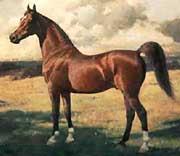American Saddlebred
Kentucky Saddler
Tue, 19th November, 2024 - 9:35 am GMT
Sponsor Ads:

Alternative Name
Kentucky SaddlerBasic Info
The American Saddlebred with its conformation, personality, and stamina is suited to accomplish any task requested, but is most well-known as the "peacock of the horse show world". The horses used for the show ring are flashy, high-stepping animals, with exaggerated action. The Saddlebred is very sensitive and alert. The ideal American Saddlebred is well-proportioned and presents a beautiful overall picture. Large, wide-set expressive eyes and gracefully shaped ears set close together are positioned on a well-shaped head. The neck is long with a fine, clean throatlatch and is arched and well-flexed at the poll. The American Saddlebred sports well-defined and prominent withers, while the shoulders are deep and sloping. Well-sprung ribs and a strong level back also characterize the breed. The legs are straight with broad flat bones, sharply defined tendons and sloping pasterns Saddlebreds are usually black, bay, chestnut, or brown, but grays, buckskins, palominos, pintos and occasionally roans are also found. The average height is 15-16 hh, but can also be as small as 14.2 hh or taller than 17 hh.
Health
N/AHabitat
N/ABehavior
Saddlebreds can also be five-gaited, performing not only the walk, trot, and canter, but the slow-gait and rack. The slow gait is a four-beated gait performed in a prancing motion, lifting the legs very high. The rack is a more ground-covering four-beat gait, and is much faster, with the horse snapping their knees and hocks up quickly. Ancestors of the Saddlebred were naturally gaited, and many Saddlebreds today can naturally perform them, and most can learn the additional gaitsOrigin
United States (KentuckyHistory
In the 18th century, American colonists crossed the Narragansett Pacer with the Thoroughbred. Known as the American Horse, this cross was used in the Revolutionary War, and made its way into Kentucky. In the 1800s, the breed become known as the Kentucky Saddler. It was used mainly on plantations because of its comfortable, ground-covering gaits, and sure-footed manner. It was developed into a very stylish, fancy horse: beautiful for harness, strong enough for farm work, fast enough for match races. In the 1830s, Morgan and Thoroughbred blood was added to give the more substance and action. This produced the American Saddlebred. The horse gained popularity in the 1940s. The stallion Denmark, born in 1939, became the foundation sire, with over 60% of today's Saddlebreds tracing back to this one horse. General Robert E. Lee had a Saddlebred named Traveller; Generals Ulysses S. Grant and Stonewall Jackson also rode Saddlebreds. After the American Civil War ended, breeders began promoting the breed as a show horse, breeding for flash and animation. Many film television horses were also Saddlebreds, such as "Mr. Ed," Roy Rogers' "Trigger," and the Lone Ranger's "Silver." One of the most famous Saddlebreds in the world of show horses was Wing Commander (1943 – 1969). A six-time World Grand Champion, he became an important sire of saddle show horses.Common Foods
grassSponsor Ads:
whereof one cannot speak, thereof one must be silent -- Ludwig Wittgenstein
American Saddlebred
Coded by: BGID® | ALL RIGHTS RESERVED Copyright © 2000-2024
Disclaimer | Privacy | Report Errors / Contact | Credits








 Politician, US Vice President and President of the USA - Joseph Robinette Biden Jr.
Politician, US Vice President and President of the USA - Joseph Robinette Biden Jr.  President of the United States of America - Real Estate mogul, Pageant owner and now one of the most controversial men in political history.
President of the United States of America - Real Estate mogul, Pageant owner and now one of the most controversial men in political history.  versus
versus  Russia: 'The Evil Empire'? Are they all that bad or is it just the USA trying to portray Russia as bad because they are a world power with land bigger and a society very different from the USA ideal?
Russia: 'The Evil Empire'? Are they all that bad or is it just the USA trying to portray Russia as bad because they are a world power with land bigger and a society very different from the USA ideal?  Global warming has been in and out as the "latest" hot topic for many years. It is, according to modern scientists, the result of man-made industrial pollutants, clearing forested areas, agriculture, etc. But now they are thinking it started way before the Industrial Revolution...
Global warming has been in and out as the "latest" hot topic for many years. It is, according to modern scientists, the result of man-made industrial pollutants, clearing forested areas, agriculture, etc. But now they are thinking it started way before the Industrial Revolution... 
 Corona virus
Corona virus 
 Users with wide screen monitors can benefit from more content on every page.
Users with wide screen monitors can benefit from more content on every page.